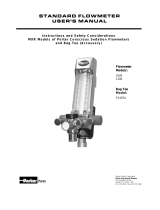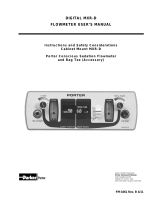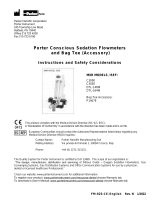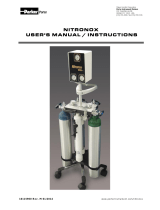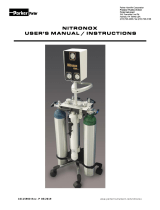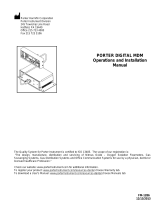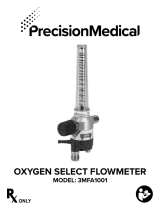Page is loading ...

FM-916 Rev. M 1/22
Parker Hannifin Corporation
Precision Fluidics Division
Porter Instrument
245 Township Line Road
Hatfield, PA 19440
Office 215-723-4000/Fax 215-723-5106
MOBILE “E” TANK STAND INSTALLATION AND INSTRUCTIONS
Warnings and
Precautions
Important: In addition to these
Mobile “E” Tank Stand
Instructions, read the Conscious
Sedation Flowmeter User’s Manual
/ Instructions, which includes
these flowmeter topics:
Warnings and Precautions
Delivery Technique
Safety Checks
Maintenance and
Troubleshooting.
Also read Regulators Instruction
Manual FM-1087
Examination
Examine shipping carton for signs of
external damage.
Remove contents from carton and inspect
for visible damage or missing parts.
Remove any accessories.
Check that hoses are connected.
If damage is discovered or suspected
and/or parts are missing, notify Porter or
authorized distributor immediately.
Perform initial monthly leak test prior to
use.
PORTER CUSTOMER SERVICE: 215-723-4000
www.porterinstrument.com
WARNING
Verify gas indexing pins locations.
See illustrations in
Attachment of Cylinders (Page 5)

Warnings and
Precautions
These warnings and precautions are to help you
to understand how to safely operate a Mobile E-
Stand in a Conscious Sedation System. A
WARNING alerts you to a possible hazard to
people. A CAUTION alerts you to the possibility
of equipment damage.
WARNING: New or modified installations -
properly connected gas pipelines (external
supply to E-Stand) are absolutely essential to
patient safety. The ultimate responsibility of
assuring that lines are not crossed rests with
the user. See next page for details.
WARNING: Porter Instrument equipment utilizes
the cross+protection system. The flexible hose
and connectors that connect to the E-Block and
the flowmeter inputs are diameter indexed; 3/8”
O.D. for Nitrous Oxide and ½” O.D. for Oxygen.
The cross+protection system is designed to
prevent misconnection of Oxygen and Nitrous
Oxide hoses. DO NOT ATTEMPT TO CHANGE
THE DIAMETERS OR CONNECTORS OF THE
E-Block! Tampering with the cross+protection
system constitutes acceptance of liability by the
installer.
WARNING: The E-Stand within a Conscious
Sedation System, with Flowmeter, is intended to
be used by medical personnel trained in the
flowmeter device use and the use of nitrous oxide
and oxygen for medical applications.
WARNING: Do not use the Flowmeter device for
the administration of general anesthesia or as a
part of, or in conjunction with, a general
anesthesia administration system.
WARNING: Inspect and maintain the analgesia
delivery system to prevent N2O leaks in all
hoses, connections and fittings. This includes the
delivery system (E-Stand is mounting accessory)
and the hoses and connections to the E-Block.
Have all leaks repaired immediately.
WARNING: Use Scavenging: Medical workers
are exposed to N2O during administration of
N2O/O2 conscious sedation analgesia. Controls
are effective in the patient treatment area to
achieve low levels of ppm (parts per million)
exposure. Controls include System Maintenance,
Ventilation and Work Practices. Your accessory
Scavenger System is an important part of the
system of controls in medical settings.
WARNING: (connections for external gas
supplies): 50 - 55 psi line pressure. Follow safe
connection protocol in this order: Connect
external gas supply hoses to DISS (Diameter
Indexed Safety System) fittings of Flowmeter (O2
first); then connect to external supply source. Do
not disconnect with supply line pressurized
[disconnect at supply source per appropriate safe
protocol].
WARNING: During any power outage, remember
to turn OFF the flowmeter and manually turn OFF
the tank valves (or external supplies). With
centralized, electrically powered gas systems, if
gas was flowing when the power went out and
the flowmeter is left ON, gas will be flowing when
the power is restored.
WARNING: Always use clean, dry medical grade
gases. Do not introduce moisture or other
contaminants into the system and flowmeter
device. Never oil or grease any part of this
system (minimize fire or explosion potential).
Cylinder mount: Do not clean check valve
entrance or sealing washer (replace as
needed) with disinfectant. User should
ensure that the cylinder valve is clear of dust or
dirt which may be carried to regulator and cause
damage or accident. One clearing technique is to
“crack” [secure] cylinder valve before installing
cylinder to E-Block. Open valve slightly and then
close. Do not discharge flow of gas at any person
or flammable material.
CAUTION: Do not attempt to repair, alter or
calibrate the system or flowmeter device (except
as directed in Porter User’s Manuals).
Unauthorized repair, alteration or misuse of the
flowmeter device is likely to adversely affect the
performance and will void the warranty.
2

3
WARNING: NEW OR MODIFIED INSTALLATIONS
ALWAYS ASSURE THAT LINES ARE NOT CROSSED!
WARNING: External Source Connections: New or modified central supply installations - properly
connected gas pipelines leading to any external supply of the E-Stand are absolutely essential to
patient safety. Per NFPA 99, the certified medical gas plumber, and verifier, should provide written
documentation that all gas pipelines are connected properly and that the system has been pressure
tested prior to use. While this is a good business practice, it is important that the user verify by their own
test, independent of the authorized distributor or contractor, that all gas pipelines are connected correctly
prior to using the system. The ultimate responsibility of assuring that lines are not crossed rests
with the user.
Do not allow crossed lines to defeat the safety features of the E-Stand, with any external gas
supply, and/or central gas supply manifold systems. Crossed lines will create a dangerous and
hazardous condition where, under a loss of oxygen supply, 100% nitrous oxide will be delivered
through the oxygen delivery path and subsequently to the patient.
User should observe the patient to prevent over sedation in the event of an oxygen failsafe
malfunction or crossed lines. If a patient becomes over sedated when being delivered 100%
oxygen [during an apparent loss of nitrous oxide supply], it is a definite indication of crossed
lines or a failsafe malfunction. Remove the mask immediately and encourage mouth breathing.
Deliver pure oxygen from an oxygen demand valve only if the oxygen source is independent from
the suspected crossed lines area.
INTENDED USE:
Flowmeter for a conscious sedation system:
The flowmeter device is intended for patient use and delivers a mixture of nitrous oxide and oxygen
gases during an analgesia (moderate) conscious sedation procedure in a medical healthcare setting by
trained medical personnel. Porter Instrument recommends the user be thoroughly familiar with the use
of Nitrous Oxide - Oxygen Conscious Sedation for patient analgesia and be properly trained in its
administration prior to using this product. For training requirements on the administration of Nitrous
Oxide - Oxygen Conscious Sedation, contact the appropriate regulatory authority in your country, state,
or province. Training is recommended to provide a practical, hands-on capability and an understanding
of the behavioral aspects of Nitrous Oxide Sedation and will complement the safety features of this
device.
INTENDED USE:
Mobile “E” Tank Stand within a conscious sedation system:
The Porter Mobile “E” Tank Stand is for use with two “E” tanks of O2 and two “E” tanks of N2O. The two
pressure gauges reflect tank pressure only. When the gas supply is opened, gas will flow through the
check valves into the block and be regulated down to 53 PSIG at the regulators, out through the hoses to
the flowmeter. The check valves prevent the gas from flowing between tanks or out into the room if only
one tank is in use. Each Mobile Stand may be adjusted to a desired height for operatory use and
storage.

4
Model 2045-3 “E” Stand (Figure 1)
The Tall Mobile “E” Tank Stand 2045-3 features
swivel yokes for ease of installing and removing the
O2 and N2O tanks on the stand. The stand height
adjusts from 42” to 50” to top of the meter.
Mounting Flowmeter to “E” Stand
1. Screw the bottom of flowmeter to the top of the
center post on the mobile “E Stand as in Figure
1.
2. To telescope flowmeter, loosen knob (not
shown) on rear of “E” block, position flowmeter,
retighten knob.
Caution: Fully tighten the knob after attaching
flowmeter. Failure to do so may result in damage to
flowmeter or to E-Stand.
Caution: Do not remove snap ring or o-ring on inner
post assembly (Item 2). Removing either of these
items may result in damage to flowmeter or to E-
Stand.
Model 2045-SHORT3 “E” Stand (Figure 2)
The Porter Mobile “E” Tank Stand 2045-SHORT3
features swivel yokes for ease of installing and
removing the O2 and N2O tanks on the stand. The
stand height adjusts from 31” to 41” to top of the
meter. The mounting bracket design allows for
flowmeter installation and adjustment to the desired
height for operatory use, and then to be adjusted
for under the counter storage.
Mounting Flowmeter to “E” Stand
1. Remove cap from flowmeter mounting adapter
using Philips screwdriver.
2. Slide mounting bracket on back of flowmeter
over mounting stem of “E” Stand.
3. Replace cap and tighten screw.
Position small diameter of cap “down” to
allow for swivel mounting.
Position small diameter cap “up” to fix
direction of flowmeter.
4. To telescope flowmeter, loosen knob on rear of
“E block, position flowmeter using knob on
angle bracket.
5. Retighten knob.
Figure 1 – Model 2045-3
“E” Stand with Flowmeter
Figure 2 – Model 2045-SHORT3
“E” Stand with Flowmeter

5
Proper Attachment of Gas Cylinders (E-Stand)
1. Loosen the Tee Handle (Fig. 3.1) until point is even
with the inside of the Swivel Arm. Push Tee Handle
inwards to flip to open position. Align Tee Handle
vertically (Fig. 3.2).
2. Undo the Hook & Loop straps on the Cylinder
Restraint (Fig. 3.3)
3. Cylinder Preparation: Remove any plastic
wrap/washer from the top of cylinder. Keep cylinder
top clean. Verify that the rubber washer (Fig. 3.5)
provided with the E-Stand is still in place. Do not
mount cylinder if washer is missing use the rubber
E-Stand washer (replace once/yr. or earlier if
needed).
4. Mount the “E” cylinders of Oxygen and Nitrous Oxide
(not included) to the E-Stand Block. Insert cylinders
correctly on indexing pins and as marked on Block
(N2O Figs. 3.4, 3.5; O2 Figs. 3.6, 3.7). Pins assure
mounting in appropriate position.
N2O pins Rubber
Washer
O2 Pins
Warning
Do not remove or alter gas indexing pins
Verify correct pin locations (illustrations).
5. Slide the cylinder into place by lining up the pins and
pin holes on the cylinder. Push into place. Properly
placed, the cylinder should hang on the pins (Fig. 4).
6. Cylinders should hang freely between wheel base. If
the wheel base interferes, loosen and rotate cylinder
restraint.
7. Push inwards & Rotate swivel clockwise to close
(Fig. 5.1). Pull fully outwards on Tee Handle and
swivel will lock in place. Assure swivel is in parallel
alignment with E-Block surface (Figs. 5.2, 5.3). Gaps
between swivel and posts should be equal on both
sides and the bolt head should not be evident.
Fig. 5.2 Aligned Fig. 5.3 Misaligned
8. Swivel should stay in the locked aligned position
when Tee Handle is tightened securely. Warning:
Tee Handle not tightened securely may
result in cylinder leakage with possible
loud hissing or popping sounds. Close
cylinder valve and follow procedures to correctly
align and tighten Tee Handle.
9. Secure the Hook & Loop straps to hold cylinder in
place (Fig. 5.4).
10. The Valve Wrench (hanging from black Knob) is
used to open/close Cylinder Valves (Fig. 6).
Caution: When removing cylinders, always
be sure valves are closed tightly.
Fig. 3.1
Fig. 5.4
Fig. 6
Fig. 5.1
Fig. 3.6
Fig. 3.2
Fig. 3.3
Fig. 3.5
Fig. 3.4
Fig. 3.7
Fig. 4

6
Cylinder (Tank) Operation / Maintenance
Cylinder Pressure Readings: Oxygen is a true
compressed gas, while in the cylinder, thus the cylinder
pressure gauge can be used to determine the amount of
gas remaining in the cylinder. For example, 2000 psi
indicates full, 1000 psi indicates half full, etc. Nitrous
Oxide is a liquefied compressed gas that vaporizes in
the cylinder, thus the cylinder pressure gauge cannot be
used to determine the amount of gas remaining in the
cylinder until all liquid in the cylinder vaporizes. While
liquid remains in the cylinder, the cylinder pressure
gauge indicates the vapor pressure which depends on
and varies with the temperature of the liquid. For
example, at 68ºF, the vapor pressure is about 750 psi; at
20ºF, it drops to about 400 psi; while at 90ºF, it
increases to about 1000 psi. After all the liquid
vaporizes, the pressure will decrease normally as the
gas is withdrawn, and the cylinder pressure gauge can
then be used to determine the amount of gas remaining
in the cylinder.
Caution
NEVER ATTEMPT TO LOOSEN cylinder valve
packing nut. If valve stem is tight, return cylinder
to supplier.
Warning: Do not remove or alter gas
indexing pins. Verify correct pin locations
per illustrations.
Warning: Always turn on CYLINDER VALVES slowly
and fully (minimize fire or explosion potential).
Good Practices: Cylinders with E-Stand
1. Two cylinders of O2 and two cylinders of N2O are
typically connected at all times.
2. Minimize leak risks: Confirm Yoke Washers are in
place before replacing/mounting cylinders. Use
Porter #A-3399-000 replacement washers (once/yr.
or earlier if needed). Have spare washers.
3. Warning: Keep the cylinder top clean while
performing attachment so as to minimize possibility
of any foreign substance entering the regulator
cavities (minimize fire or explosion potential).
4. Minimize leak risks: With cylinder in position, rotate
swivel arm and move into secure locked position
when Tee Handle is tightened. To prevent
movement and potential damage to yoke pins,
always fasten the Hook & Loop strap restraints
around cylinders.
5. Assure E-Stand is populated with at least one full
cylinder of O2 and N2O before starting any
procedure.
6. Label each cylinder with a tag or sticker indicating
“In-Use” and “Full” (“Full” is reserve).
7. Use Cylinder Valve Wrench to open the “In-Use”
cylinders of O2 and N2O. Verify wrench is attached to
E-Block.
8. Cylinder pressure gauges on E-Block provide a
visual indication of cylinder status (see details on
Cylinder Pressure Readings)
9. Caution: If all four cylinders (or both cylinders of
one gas) are open, the two cylinders of O2 and N2O
will deplete in tandem. The “Full” cylinder will empty
with the “In-Use” cylinder and will not be available as
a future spare.
10. When “In-Use” cylinder is fully depleted, open the
spare “Full” cylinder (Close valve on empty cylinder).
Do not remove and replace partially full cylinder;
only replace with new clean full cylinder.
11. When “In-Use” O2 cylinder is depleted, the Oxygen
Fail Safe will stop N2O flow through flowmeter
automatically.
12. When “In-Use” N2O cylinder is depleted, the
flowmeter will deliver 100% O2.
After use, turn off cylinder valves.
Connect to Gas Supply
1. Connect O2 hose to flowmeter.
2. Connect N2O hose to flowmeter.
3. Connect hoses to O2 / N2O outlet fittings on
regulators. (Figure 1)
Connecting Breathing Circuits
Refer to FM-809 for User Instructions for Assembly
Installation and Cleaning of Porter Scavenger Rubber
Goods System. Also for attachment of AVS (Automatic
Vacuum Switch) and Bag Tee (with Quick Disconnect).
Refer to FM-1330 for Assembly and Installation of
Medical Breathing Circuit Scavenger System for medical
applications.

7
Monthly Check
Leak test the entire system for working pressure
leaks. Attach the hoses to a flowmeter and turn the flow
control knobs to the OFF position and the ON / OFF
switch to the OFF position.
Turn tanks ON. Pressurize the sedation gas supply lines
and “E” block with tank pressure. Turn tanks OFF. Apply
masking tape to both gauge faces. Tap lightly on gauges
and mark gauge needle positions on the masking tape.
There should be little or no movement of the gauge
needles after 15 minutes. This test with the
flowmeter tubing connections in place tests the seal of
the hose connectors, the “E” Block and the flowmeter’s
on / off switch.
CAUTION: When operating the swivel yoke, take
care not to catch or pinch fingers.
“E”-Block Cylinder Pressure Gauge
Replacement
Warning: High pressure (up to 2400 psi).
Turn OFF all tank valves / supply pressure.
Switch flowmeter on/off switch to the “on” position
and open both valves to vent the pressure.
1. Unscrew the pressure gauge.
2. Install new pressure gauge; verify PTFE tape is
applied to the NPT thread; tighten carefully so
as not to cross thread with the E-Block cavity.
3. Turn on tank valve slowly at location of the
open door.
4. Leak test per Initial and Monthly Check.
“E” Block Removal Instructions (Figure 8)
Warning: High pressure (up to 2400 psi). Turn
OFF all tank valves / supply pressure. Switch
flowmeter on/off switch to the “on” position and
open both valves to vent the pressure.
1. Unscrew (counter clockwise) the (2) Allen
screws that normally secures the block
assembly to the stand. (Use 1/8” Allen wrench.)
2. Unscrew knob and the screw that locks
telescoping post in position.
3. CAUTION: Do not allow post to drop into tube.
Push snap ring out of groove on telescoping
post.
4. Remove O-ring from post.
5. Lift off “E” block.
“E” Block Installation
Install new “E” block assembly by reversing
removal instructions.
Figure 7 – “E” Block with Swivel Yokes
Figure 8 – “E” Block
Regulator Maintenance
Warning: Do not attempt to replace
regulators in the field.
Troubleshooting:
Do not use E-Stand if there is a significant
change in the attached flowmeter flow
capability.
Do not use E-Stand if any abnormal sounds
(like sputtering, popping, etc.) are heard coming
from the regulator area.

8
Maintenance and Service – Recommended Replacement Parts
Part Number
Qty Per
2045-3
2045-SHORT3
Item
Description
Unit
A-3369-000
NA
1
Mounting Stud with Washer
1
A-3372-000
A-4052-000
2
Inner Post Assembly with Mounting Stud
1
A-3399-000
3
Yoke Washers
4
B-1883-001
B-4668-000
4
Tube Assembly Only
1
PA-1185-000
5
Tank Wrench with Chain
1
C-1658-000
6
E-Stand Tank Restraint Kit
1
91505113
7
5 Star Base
1
PA-234-004
8
Caster
5
65958000
9
Ribbed End Cap
5
A-4060-000
10
Tee Bar Handle
4
A-4434K
11
Check Valve Assembly Kit
4
NA
B-4669-000
12
S- Bracket Assembly
1
8003
NA
13
3 Ft Hose, O2, Diss / Diss
1
8503
NA
14
3 Ft Hose, N2O, Diss / Diss
1
NA
8082
15
2 Ft Hose, O2, Diss / Diss Elbow
1
NA
8582
16
2 Ft Hose, N2O, Diss / Diss Elbow
1
64900423
17
Gauge O2 Cylinder Pressure (0-4000 psi)
1
64900422
18
Gauge N2O Cylinder Pressure (0-4000 psi)
1
649004C
19
Gauge Cover (Threaded)
2
649004RC
19
Gauge Cover (Snap-on)
2
Note: Do not recommend replacing regulators in the field. Return to Porter for servicing.
Troubleshooting the Attachment of Cylinders:
Warning: Tee Handle not tightened
securely may result in cylinder leakage with
possible loud hissing or popping sounds. Close
cylinder valve and follow procedures to correctly
align and tighten Tee Handle.
Aligned Swivel
Misaligned Swivel
See Attachment of Cylinders Section
- New Gaskets P/N: A-3399-000 (Replace all 4
once a year or earlier if needed).
- Tee Handle is pulled outwards and aligned.
- Swivel is parallel with E-Block
- Bolt head not evident.
- Maintain aligned swivel position as Tee Handle
is securely tightened.
Bolt Head is Evident

9
Replacing the Check Valve (Figure 9 & 10)
The check valves are designed to perform for the
life of the E-Stand, but are field replaceable.
Replace check valves if leaking occurs.
Warning: High pressure (up to 2400 psi). Turn
OFF all tank valves / supply pressure. Switch
flowmeter on/off switch to the “on” position and
open both valves to vent the pressure.
1. Back out Tee Handle (Item 10) until point is
even with the inside of the swivel arm.
2. Push Tee Handle “in” to open swivel.
3. Swing swivel arm open. (Figure 9)
4. Remove rubber washer (Item 3). It is
recommended that these be replaced once a
year.
5. Unscrew check valve assembly using a 5/8”
socket with ratchet.
6. Install new check valve assembly (Item 11) by
reversing above steps.
WARNING
Do not remove or alter gas indexing pins.
Figure 9 – Check Valve Replacement
Figure 10 – Check Valve Locations
Cleaning Methods
We recommend the use of an approved disinfectant
for the healthcare patient environment for cleaning
the outside of the device. Do not spray disinfectant
directly onto parts. Spray disinfectant into
disposable towel, or use disinfectant surface wipe
(avoid excess disinfectant liquid), and wipe unit
thoroughly removing excess disinfectant to
eliminate buildup. Follow the disinfectant
manufacturer’s directions for use.
Introduction of moisture or other contaminants into
this device may result in defective operation. Never
oil or grease any part of this system (minimize fire
or explosion potential). Cylinder mount: Do not clean
check valve entrance or sealing washer (replace as
needed) with disinfectant.

CERTIFICATE OF WARRANTY
THIS WARRANTY IS GIVEN IN PLACE OF ALL OTHER WARRANTIES, EXPRESS OR IMPLIED, OF
MERCHANTABILITY, FITNESS FOR A PARTICULAR PURPOSE OR OTHERWISE.
Under no circumstances shall Parker Hannifin Corporation be liable for incidental or consequential
damages as those terms are defined in the uniform commercial code.
Parker Hannifin Corporation, Porter Instrument Division warrants that each product or part shall be free
from defects in workmanship and materials, under normal use and with appropriate maintenance, for one
(1) year from the date of delivery to customer unless otherwise specified in writing. All rubber and plastic
parts and accessories are warranted under the same conditions for a period of ninety (90) days from
date of purchase.
No statement or claim about the product by any employee, agent, representative, or dealer of Parker
Hannifin Corporation shall constitute a warranty by Parker Hannifin Corporation or give to rise to any
liability or obligation of Parker Hannifin Corporation.
Parker Hannifin Corporation shall not be liable for any damage, injury or loss arising out of the use of the
product, whether as a result of a defect in the product or otherwise, if, prior to such damage, injury or
loss, the product was (1) damaged or misused; (2) repaired, altered or modified by persons other than
Parker Hannifin Corporation; (3) not installed in strict compliance with applicable codes and ordinances;
or (4) not installed by an authorized Parker Hannifin Corporation dealer. Parker Hannifin Corporation's
obligation for breach of this warranty, or for negligence or otherwise, shall be strictly and exclusively
limited to the repair or replacement of the product or part. This warranty shall be void on any product on
which the serial number has been altered, defaced or removed.
ORDERS All orders are to be made through authorized Parker Hannifin Corporation distributors. All
billing will be done through said distributors. Direct orders will be handled through the authorized local
dealer as determined by Parker Hannifin Corporation.
RETURNS All returned merchandise will be handled through the local Parker Hannifin Corporation
distributor. No returns will be accepted unless authorized in writing by Parker Hannifin Corporation and
accompanied by the original shipping invoice. All returns are subject to restocking charge.
Policies subject to change without notice.
The Quality System for Porter Instrument is certified to ISO 13485. The scope of our registration is:
“The design, manufacture, distribution and servicing of fluidic components and integrated systems for
use in the Medical Equipment, Diagnostic, Biopharmaceutical, Agent Detection, Analytical
Instrumentation and Industrial markets, Nitrous Oxide – Oxygen Sedation Flowmeters, Gas Scavenging
Systems and Gas Distribution products for use by a physician, dentist or licensed healthcare
professionals.”
This product complies with the Medical Directive (93/42/EEC). A “Declaration of Conformity” in accordance with the
directive has been made and is on file.
European Communities should contact the Authorized Representative listed below regarding any Medical Device
Directive (MDD) inquiries.
Contact Name: Parker Hannifin Manufacturing Sarl
Mailing Address: Via privata Archimede 1, 20094 Corsico, Italy
Phone: +0223077419
/
